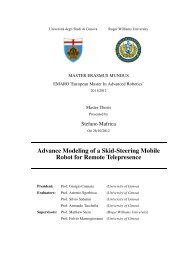SECCM Assessment Plan - Roger Williams University
SECCM Assessment Plan - Roger Williams University
SECCM Assessment Plan - Roger Williams University
Create successful ePaper yourself
Turn your PDF publications into a flip-book with our unique Google optimized e-Paper software.
The Engineering program was originally designed to allow students to select their<br />
engineering electives from a variety of courses that would provide an interdisciplinary<br />
engineering perspective. While some students pursued a diverse selection of electives,<br />
others concentrated their elective choices in one of the more traditional engineering<br />
disciplines such as civil or mechanical engineering. As the program matured, assessment<br />
tools indicated a clear desire from those students who concentrated their electives to be<br />
awarded some formal recognition for their concentrated course of study.<br />
The decision to award formal recognition was studied in depth by the program faculty. While<br />
there was a clear desire to preserve the “general” nature of the program, the faculty realized<br />
that one of the central attributes of a general engineering program was the student’s<br />
exposure to a range of engineering areas. The faculty concluded that student specialization<br />
of elective choices was a natural outgrowth of the program and a major strength.<br />
Accordingly, in Academic Year 2001-2002, the faculty developed curricular criteria for<br />
awarding minors in five disciplinary areas: civil, computer, electrical, environmental and<br />
mechanical engineering. Minor options were first offered in Academic Year 2002-2003. In<br />
most cases, students desiring to minor are required to take additional courses that result in a<br />
total program credit hour count higher than the nominal 125 credit hours. It is important to<br />
recognize that there is no requirement for students to pursue a minor and students are still<br />
free to select their engineering electives from the total offerings. The elective courses offered<br />
by the program are listed in Table 2.3, Engineering Proficiency Courses.<br />
Table 2.3 Engineering Proficiency Courses<br />
Course Number Course Title Credits<br />
COMSC 110 1 Introduction to Computer Science and Lab 4<br />
COMSC 111 1 Data Structures and Lab 4<br />
COMSC 210 1 Principles of Computer Organization and Lab 4<br />
COMSC 220 1 Analysis of Algorithms 3<br />
COMSC 230 1 Principles of Programming Languages 3<br />
CNST 250 2 Construction Equipment 3<br />
CNST 302 2 Surveying and Lab 4<br />
CNST 455 3 Mechanical and Electrical Design for Buildings 3<br />
ENGR 270 Digital Systems Design and Lab 4<br />
ENGR 314 Soil Mechanics and Lab 4<br />
ENGR 405 Air Pollution and Control 3<br />
ENGR 407 Solid and Hazardous Waste Management 3<br />
ENGR 408 Water Pollution and Treatment and Lab 4<br />
ENGR 409 Design of Structures 3<br />
ENGR 412 Water Resources Engineering and Lab 4<br />
ENGR 413 Advanced Structural Analysis 3<br />
ENGR 415 Wastewater Treatment and Lab 4<br />
ENGR 417 Groundwater Hydrology 3<br />
ENGR 424 Digital Signal Processing 3<br />
ENGR 430 Special Topics 3<br />
ENGR 431 Mechanical Vibrations 3<br />
ENGR 433 Heat Transfer 3<br />
ENGR 445 Dynamic Modeling and Control 3<br />
ENGR 450 Robotics 3<br />
ENGR 455 Data Communications 3<br />
ENGR 465 Network Analysis and Design 3<br />
Minimum Total Credits 12<br />
17
















